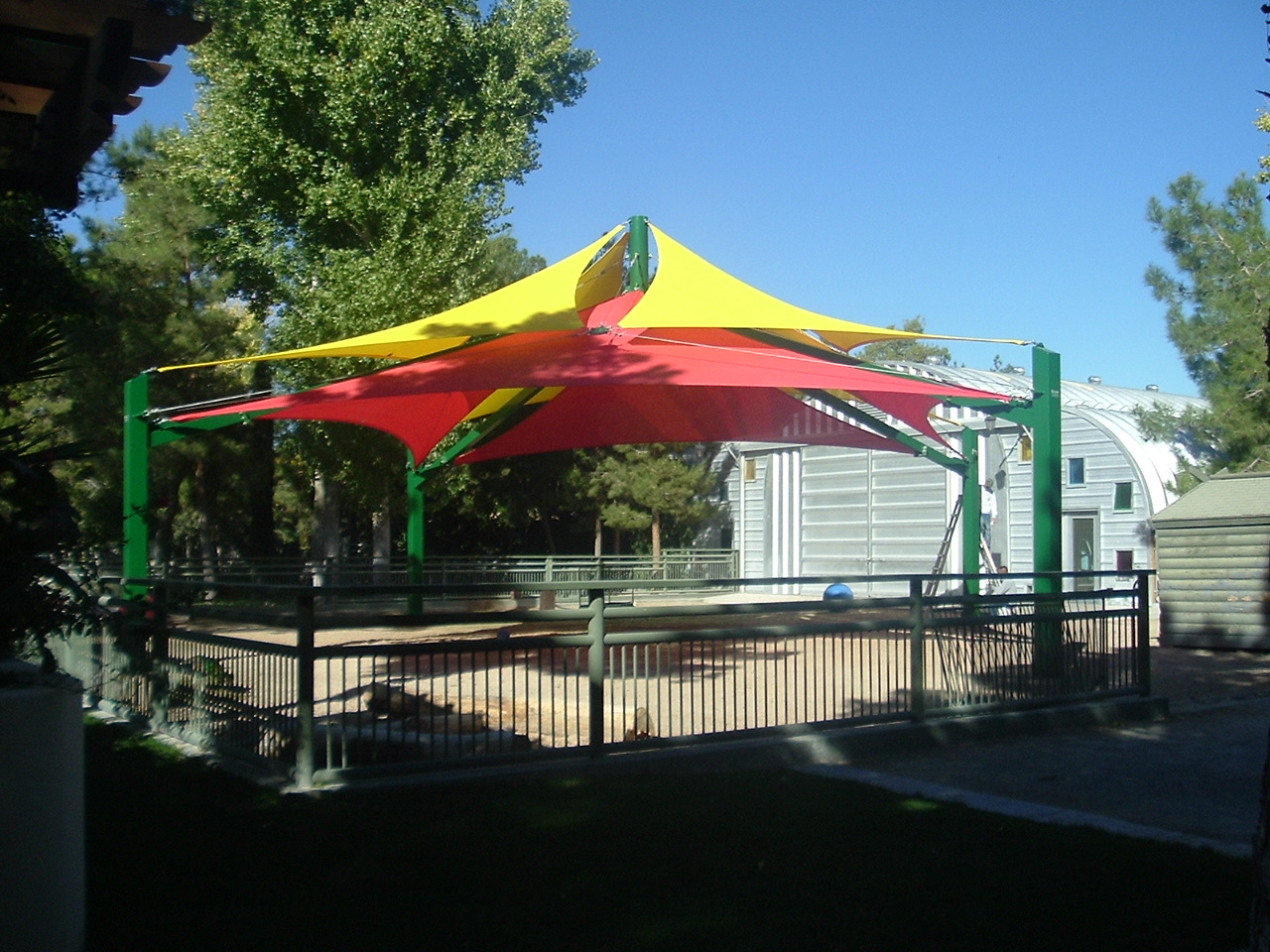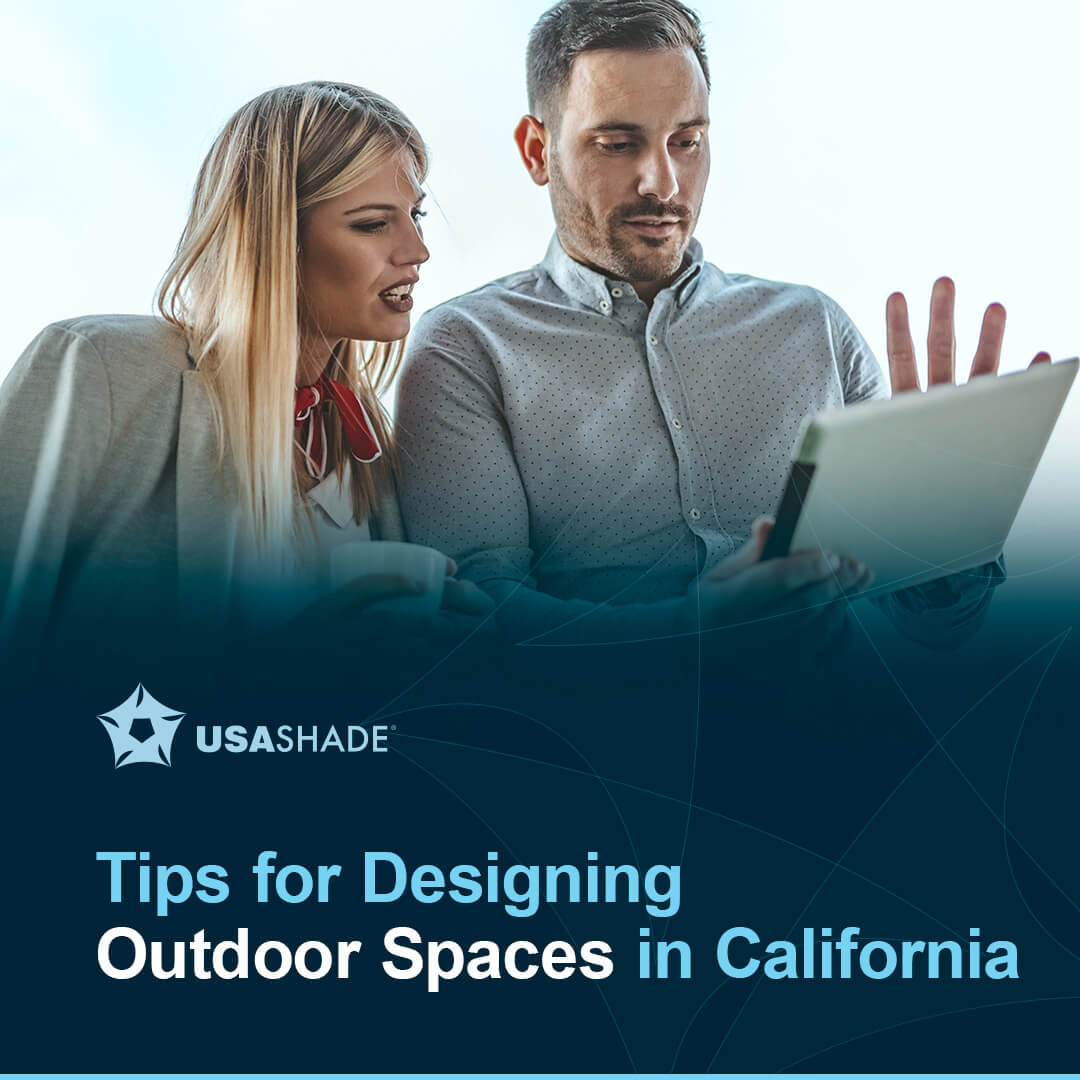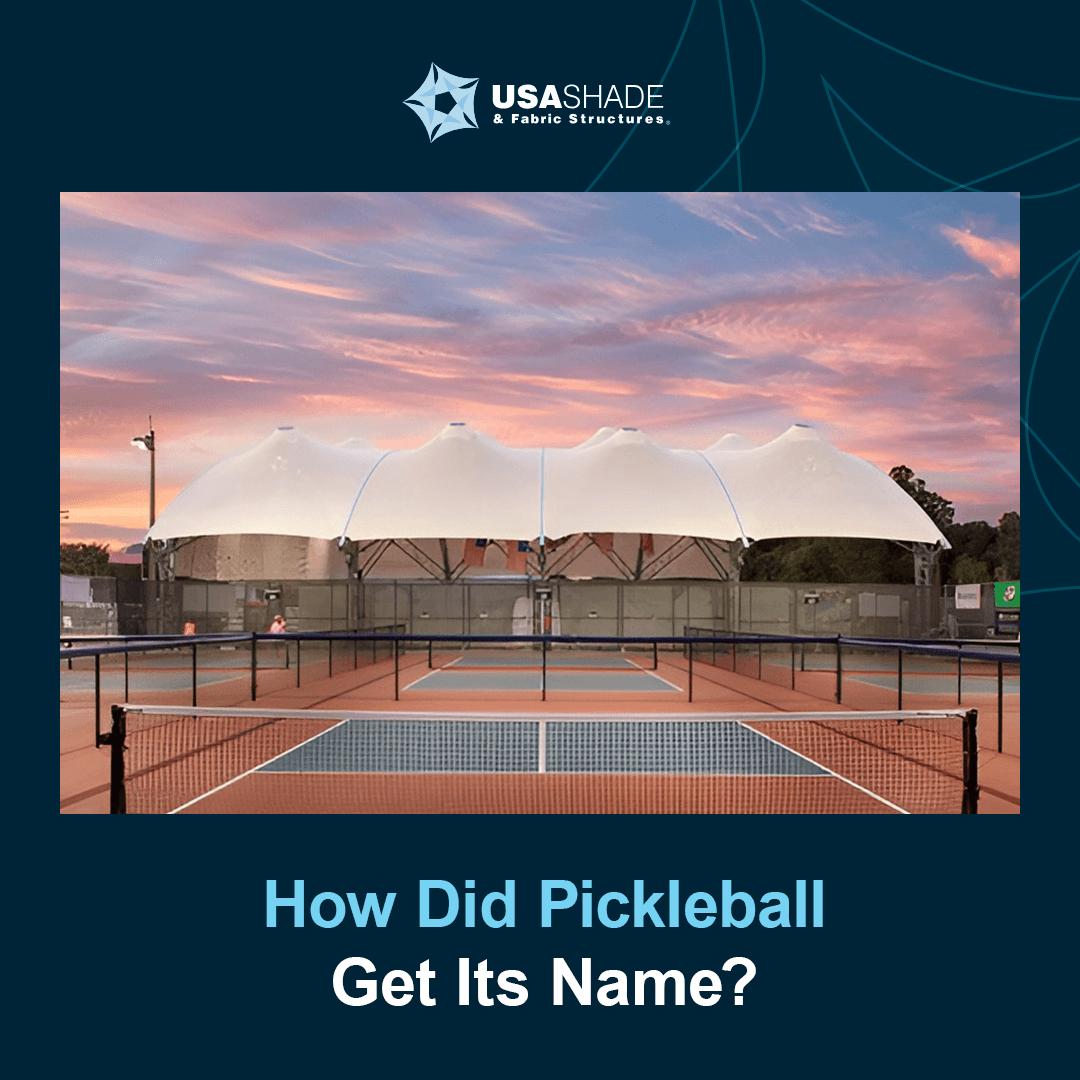
Designing a business in Arizona takes time and consideration. With high temperatures and a humid climate, many factors impact your company’s building. Whether you’re building from the ground-up or renovating your current business space, choosing the right location, picking suitable materials and making other design considerations will be vital to your business’s success.
If you’re designing a business in Arizona and need design tips to guide your decisions, look no further than the following guide. Below, we cover location, building materials, colors and other important factors that will play a key role in how your building looks and accommodates customers. Keep reading to learn more about Arizona business design considerations to help your business excel.
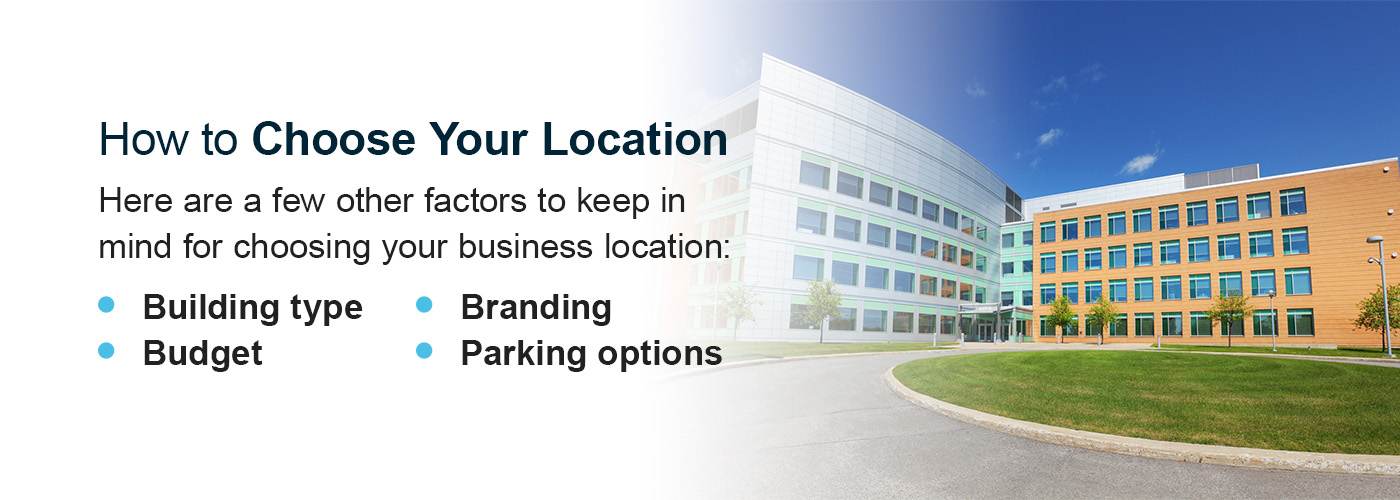

How to Choose Your Location
Although there is no specific way to choose a business location, there are some things you can think about to find the best fit for you. For example, if your business relies on foot traffic, you’ll likely want to invest in a corporate space in office buildings or retail spaces. Here are a few other factors to keep in mind for choosing your business location:
- Building type: Depending on your business type, you’ll need to consider what kind of space you need to operate in. Some businesses, such as bookstores, can go in typical storefronts, as all they need is space for stocking inventory and displaying products. Other businesses like restaurants require more space and special features.
- Budget: Like many aspects of your business, your budget will dictate where you can set up shop. Consider aspects like renovations, taxes, employee wages and utility upgrades when evaluating your budget to ensure your business will thrive in your new location. It may help to speak with other business owners in the area to discover any hidden costs or fees you might encounter.
- Branding: Your brand can direct you to the best locations for business. For example, dive bars and casual dining options do well in college towns where community members often want to minimize spending on dining experiences. Comparatively, boutiques and coffee shops do well in retail center areas where many people frequent on weekends and evenings. Placing your company where you can find the most business can help you craft the best interactions and increase your chances of success.
- Parking options: Regardless of your business’s effectiveness, parking is a key consideration for many business owners. This seemingly small factor can play a significant role. Customers who have to pay for parking may feel less inclined to pay your store a visit. If you don’t have a parking lot, you may turn away potential customers looking for a more convenient experience. Additionally, your employees need a reliable place to park so they can come to work accordingly.
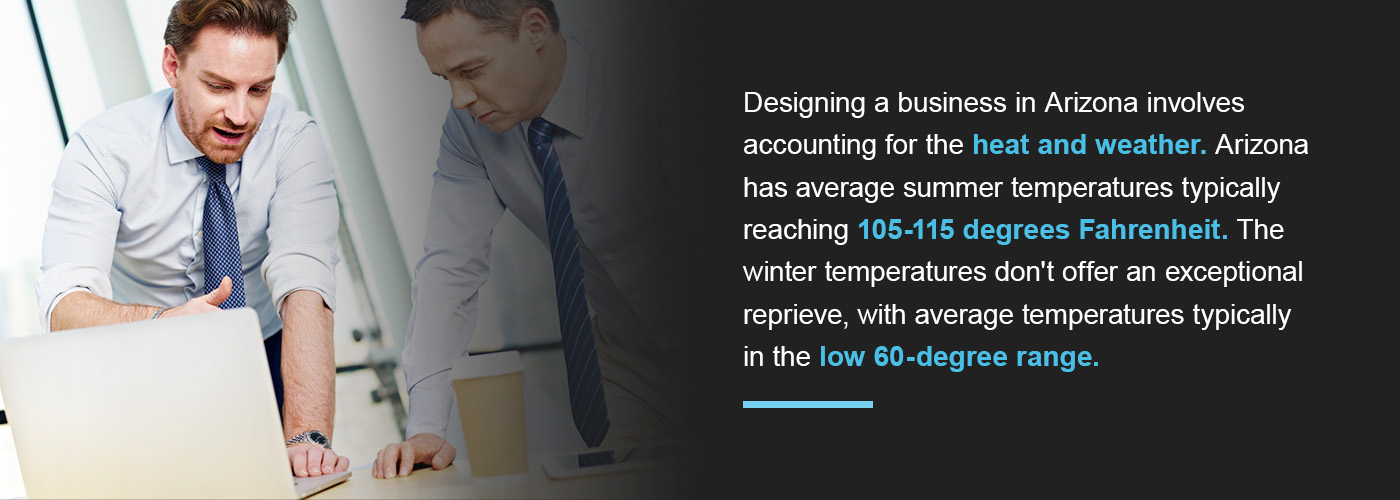
Designing Your Business for the Heat
Designing a business in Arizona involves accounting for the heat and weather. Arizona has average summer temperatures typically reaching 105-115 degrees Fahrenheit. The winter temperatures don’t offer an exceptional reprieve, with average temperatures typically in the low 60-degree range.
The materials you choose to design your business play a significant role in combatting heat. Concrete and asphalt can absorb heat during the day and retain heat throughout the night. Other considerations, like material color, can also affect your building’s temperature. For example, white materials reflect heat.
Your business’s location can also determine how many preventative measures you need to have in place. Urban areas, like Phoenix, are naturally hotter, sometimes even 10 degrees hotter, than the surrounding areas. This urban heat island effect can quickly become a deterrent for potential customers or clients. If your business doesn’t offer a reprieve from the heat, you may see fewer people walking through your doors.
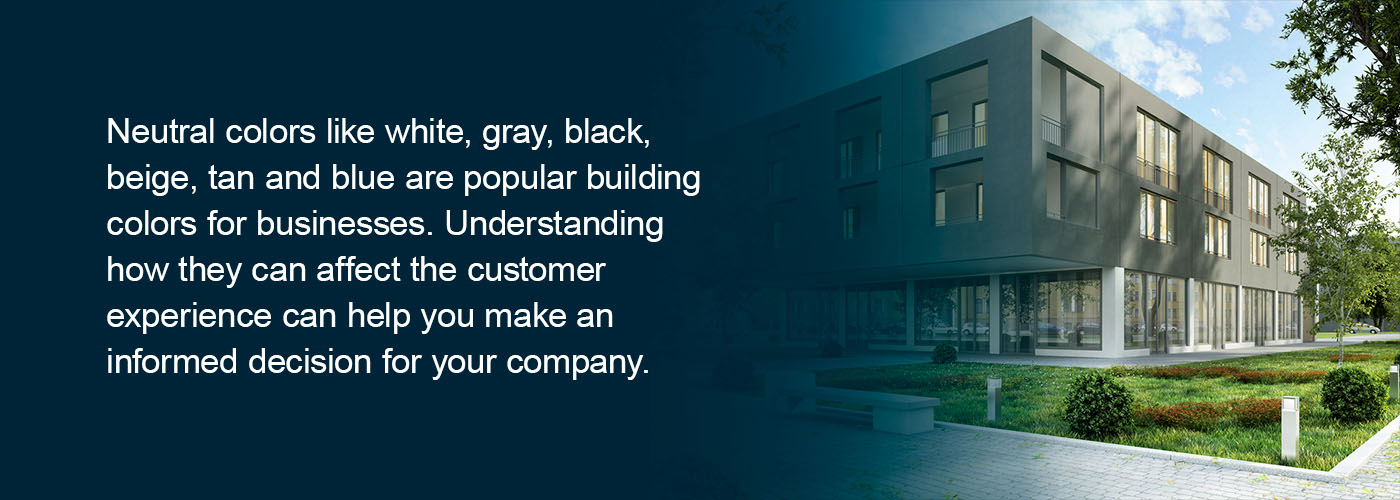

Choosing Your Building Color
Neutral colors like white, gray, black, beige, tan and blue are popular building colors for businesses. Understanding how they can affect the customer experience can help you make an informed decision for your company.
Lighter colors are better at reflecting light, while darker colors are better at absorbing heat. In areas like Arizona, where heat is a frequent deterrent for activities, lighter colors can help increase your foot traffic. Keeping light colors for the building’s interior can also help ward off unwanted heat.
Variations of white offer the best heat reprieve but can create a stark contrast against other buildings and natural settings. Finding the perfect off-white or cream can be more appealing and generate better resistance against visible eye sores from the weather, people and natural debris.
If you want to add more color, consider gray. Grays can reflect light almost as well as whites, making them a great neutral color for your building’s exterior. For more vibrance, pale yellows, teals and blue-green colors can add visual interest to your building while still warding off the heat.
Choosing Your Building Materials
In Arizona, you need to use materials that will block out the heat. Materials like concrete and asphalt are popular for building construction and can also absorb light.
Here are some popular building materials and whether they’re suitable for your business:
- Concrete: Although very durable, this material can absorb heat. For your business, this could bring warmer temperatures each day and contribute to the urban heat island effect.
- Brick: The aesthetic of brick makes it a timeless choice for many companies. Like concrete, this material can absorb heat during the day but releases heat at night. This means you may have cooler temperatures inside during peak business hours, which is the goal.
- Metal siding: Metal can be an excellent material for buildings in many climates. This material can keep consistent temperatures throughout buildings. Pairing metal with cooling elements like fans or air conditioners can create a cool and comfortable space for you and your customers.
- Stone: Stone has a high thermal mass that enables it to absorb heat and release it slowly over time. Stone’s density also prevents heat from entering your building quickly.
Ultimately, you’ll want to select building materials that will keep the interior cool during the hot Arizona summers and provide just enough warmth inside during the cooler months.
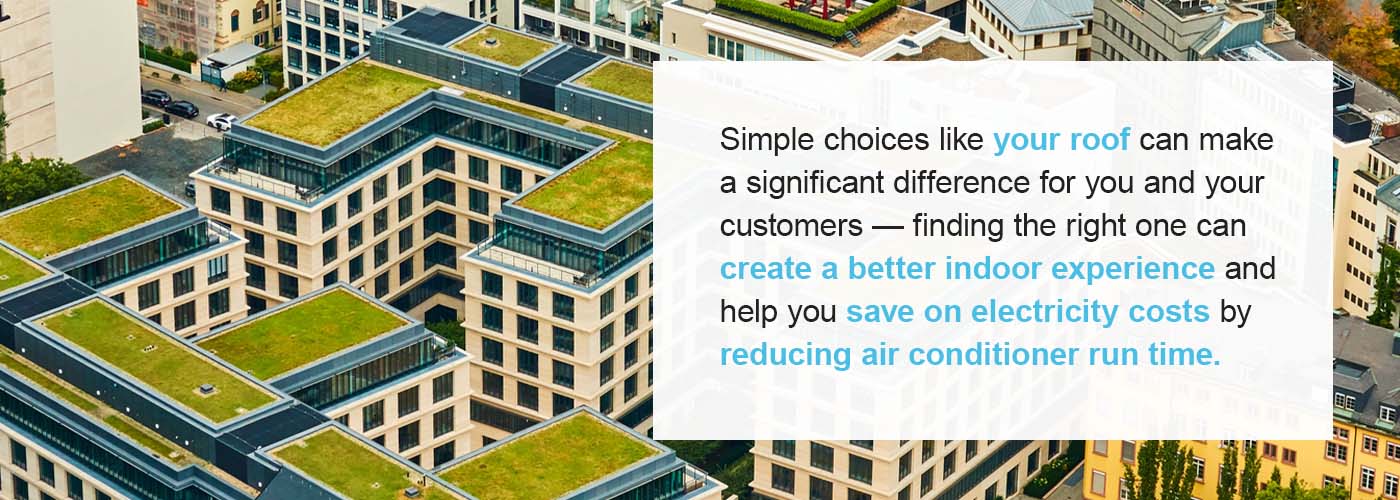

Choosing Your Roofing Options
Your building color and materials are only the first part of the design process for your business. Other vital design elements can keep your building cool and comfortable.
Simple choices like your roof can make a significant difference for you and your customers — finding the right one can create a better indoor experience and help you save on electricity costs by reducing air conditioner run time.
- Terra cotta or stone tiles: Terra cotta tiles have a curve that makes it easier for air to circulate, reducing the heat in your building. Slate tiles are a higher-end alternative. These materials are weather resistant and require less maintenance than some other roofing materials.
- Metal roofs: Metal roofs reflect tons of light, and the dead space between the roof and your interior makes them energy efficient. Additionally, metals cool quickly at night, allowing less heat to remain in your building.
- Green roofs: Another rising trend for roof options is green roofs. These unique designs have a layer of water and plants covering the top of the building. These roof options are great for the environment and are excellent at reducing heat during the summer while absorbing heat during the cooler months.
- Asphalt shingles: Asphalt shingles are another common choice for roofs. They can lower the heat transfer of your home through their engineered design. With a wide variety of color options for asphalt shingles, you can find the right color and style for your business to stand out and reflect your taste.


5 Arizona Building Design Considerations
Beyond the physical materials you choose for your building, there are other ways to keep your building cool without adding more costs. Your interior conditions can significantly impact your building’s ability to minimize energy reliance, allowing you to save money on utilities and provide a comfortable shopping or dining experience for your clientele.
The following considerations are additional ways to make your business more comfortable in the Arizona heat.
1. Building Orientation
Building orientation can affect your building’s interior temperature significantly. East- and west-facing windows lose more heat than they gain during colder months and collect more heat in the summer. Southern orientations create the least heat losses and solar gain during summer or winter months, and northern-facing windows can minimize heat losses.
Although east-facing buildings are excellent for homeowners who want to marvel at the rising sun, there may be better choices for your business. Arizona buildings facing the east or west can experience intense heat as the sun directly enters the space and contributes to higher interior temperatures.
North-facing buildings allow sunlight at the back of the building, typically providing a cooler interior. These buildings also tend to be darker as they experience less natural light.
Your best bet will be a northern-facing property in Arizona, and you can cover the remaining spaces with curtains and coverings to keep light and heat out of the space. If you’re looking to invest in an east- or west-facing building, the shade will be the best way to combat the heat.
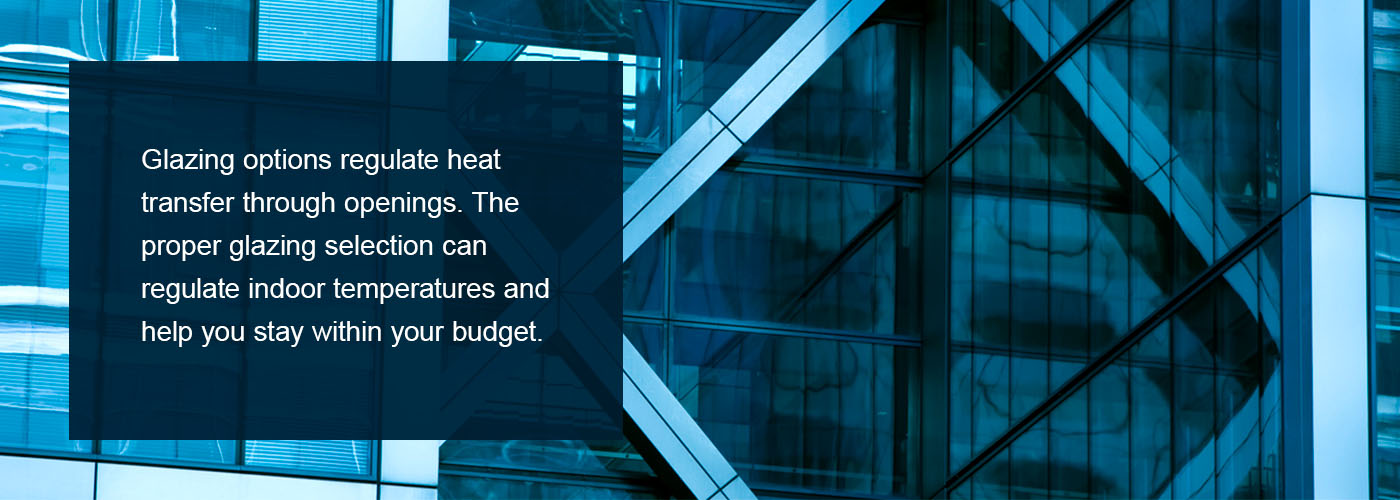

2. Glazing Selection
Glazing options regulate heat transfer through openings. The proper glazing selection can regulate indoor temperatures and help you stay within your budget. Glazing refers to the process of adding materials, like an extra glass pane, to your windows to make them more insulated.
When deciding on window glazing, you have a few options. The solar heat gain coefficient (SHGC) will provide tons of information about what glazing is right for you. Options with a low SHGC are better for warmer climates like Arizona because they’re more efficient at shading and insulating a building’s interior. This means you can allow daylight to come through the windows without bringing in excess heat.
Translucent glazing isn’t a good option if your building is east- or west-facing. Instead, opting for a double glaze can help you control the temperature by preventing heat from escaping in the winter and limiting the heat coming in during the summer. This glaze prevents heat from transferring from one side to another, giving you excellent insulation throughout the year.
3. Room Arrangement
Consider each room’s purpose when designing your building.
The amount of light you need to utilize each space is one consideration. For instance, if you have many employees or expect many guests to use a specific room, you’ll likely want to have plenty of natural light filling in. However, extreme light exposure can make your workers and customers uncomfortable or make it hard to see.
Furthermore, spaces with heat sources such as appliances or electronics can become overheated with the incorrect arrangement. You can experience adverse heat effects if you need heavy machinery or plan to use cooking appliances in bright, hot spaces.
As a general guide, sun-sensitive spaces do best facing the north or south, where the exposure is minimal. Spaces with few windows and those that won’t see much foot traffic throughout the day can benefit from the east- and west-facing rooms.
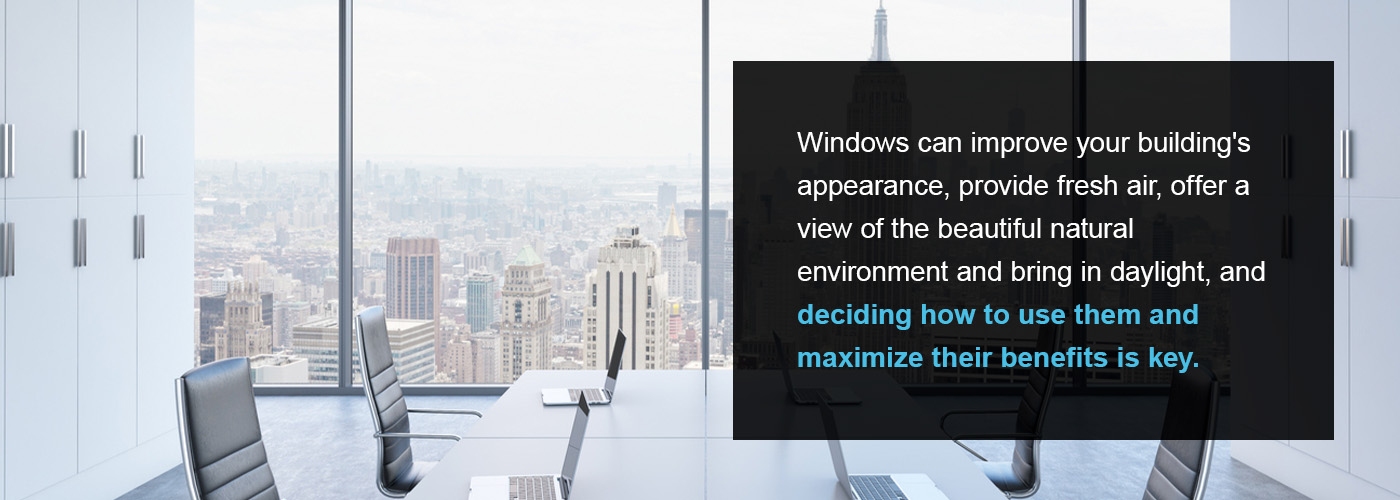

4. Window Placement
Skylights and windows are major contributors to heat gain, increasing the importance of their placement and size. Windows can improve your building’s appearance, provide fresh air, offer a view of the beautiful natural environment and bring in daylight, and deciding how to use them and maximize their benefits is key.
Glazing can be an easy way to minimize heat transfer and keep your buildings cooler. Although north or south windows may still need shade structures to reduce light or heat, glazing will be important for east or west windows that can experience a lot of glare.
Additionally, large windows will allow more light and heat to enter your space regardless of your window placement or position. If you’re considering adding multiple large windows to your business, you must prepare for additional heat and light.
5. Ventilation Options
Any air flowing through your space can feel cool. In warmer climates, allowing a calming breeze to enter your building can reduce the need for air conditioning and fans. Proper ventilation allows air to move from one end of each room to another, enabling all occupants to stay comfortable.
Understanding how air flows through your building will be a big asset in getting the best use out of your fans or air conditioners. By forcing the incoming air to take a longer path to exit your building and using smaller openings, you can increase airspeed, which increases the cooling effect.
Once you understand how the airflow through your property, you can position fans and similar appliances to enhance the cooling experience. Larger fan blades and larger constructions can move air more efficiently and move more air at one time. You can also use window fans to turn the hot outside air into refreshing cool air for your building.
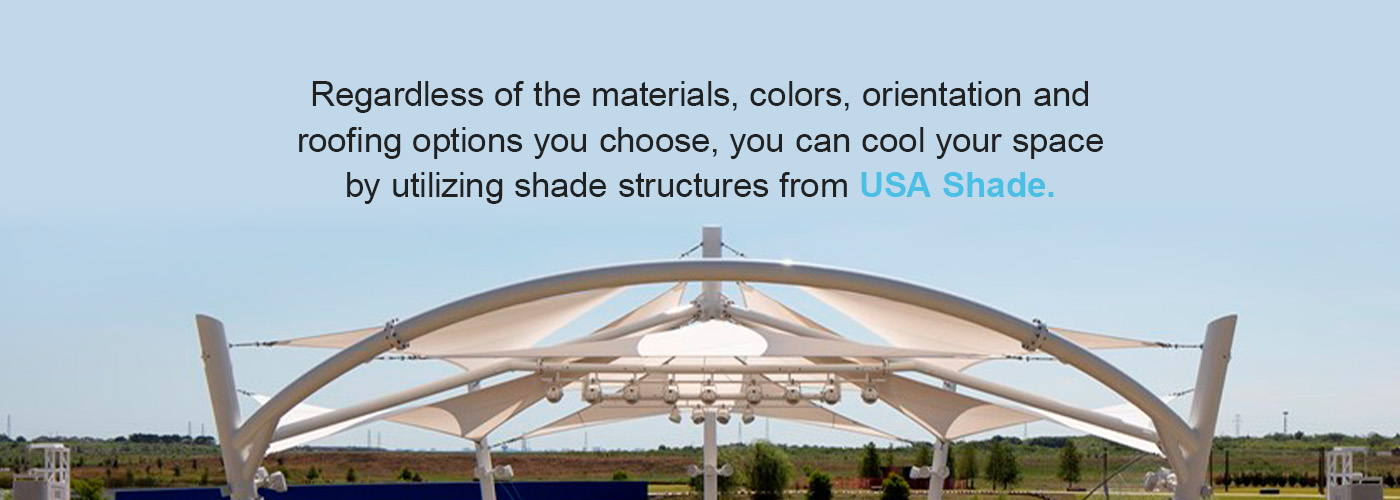

Incorporate Shade Structures Into Your Design
Regardless of the materials, colors, orientation and roofing options you choose, you can cool your space by utilizing shade structures from USA Shade. With our shade structures, you can fully customize the designs you want and experience professional fabrication and installation for unique shade structures to enhance your business.
We offer a range of shade options for businesses, including:
- Square and rectangle: Our square and rectangle designs are excellent for modern spaces needing lots of shade. These shades are cost-effective and perfect for various areas around your business, such as outdoor seating areas. With several styles to consider, you’re sure to find a square or rectangle shade structure that works for your building.
- Multi-sided: We also offer multi-sided shade structures to cover irregularly shaped or large areas, like tables and bars. These shade structures provide plenty of shade while creating an interesting look for your space. For example, you might choose our Hexagon shade structure to provide shade around a circular outdoor dining area.
- Shade sail: You can enhance your building’s curb appeal with shade sails that offer innovative designs and modern looks. Depending on the space you need to cover, you can adjust the columns used for these shade structures accordingly. Despite their interesting look, shade sails are great at offering protection, too.
We offer many more styles and designs, with the opportunity to create a shade structure that’s unique to your business.
Overall, shade structures offer a variety of benefits for your business, including:
- Sun protection: Regardless of your company vision, services or products, shade structures can protect you and your customers from the sun. If your business relies on outdoor activities, a shade structure will provide a cool reprieve from the hot and bright air. You can even incorporate shade structures over parking lots, giving your employees a protective place to park during their shifts.
- Precipitation protection: Adding a shade structure can prevent moisture from gathering on your property and save your guests from the rain. Whether you offer outdoor benches or tables or anticipate lines out your doors, a shade structure can make the area feel much more comfortable.
- Aesthetic value: Adding a shade structure is one of the best ways to add visual interest to your business. You can find many materials, colors, styles and designs to enhance your brand, message and overall tone. The fabric you choose can sport your branded colors, logos and other themes to reinforce your brand to customers and passersby.
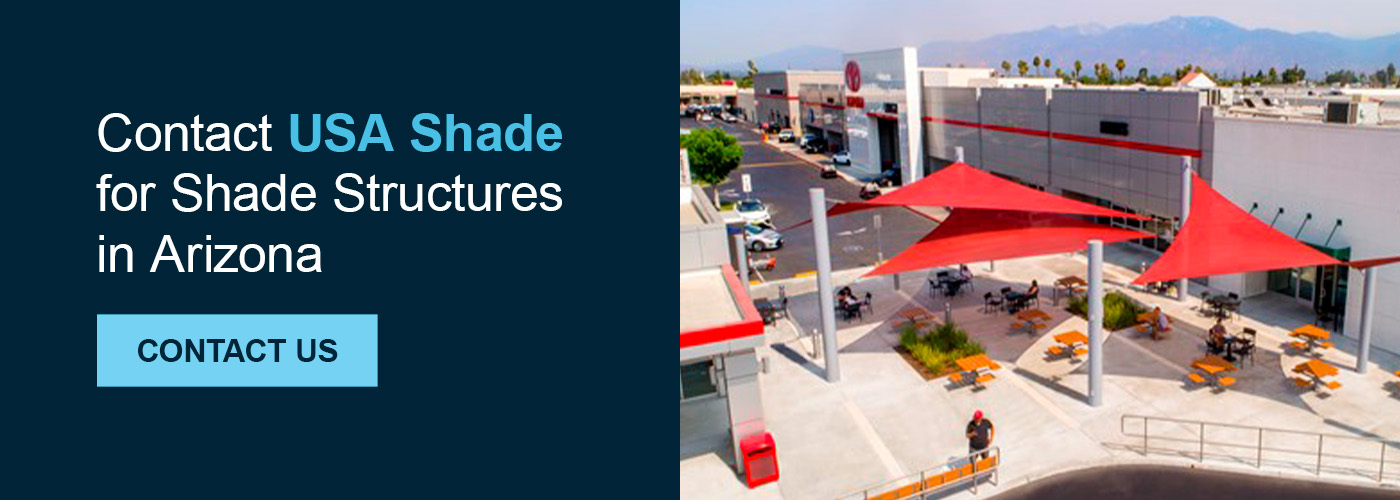
Contact USA Shade for Shade Structures in Arizona
USA Shade is a complete service shade structure manufacturer in the United States with global project experience. We’ve been pioneers in the industry since 1991, leading other businesses to innovate. An experienced team of professionals designs, engineers, manufactures and installs each of our structures. We’re always ready to assist you with any requirements you need throughout the process.
When it comes to custom projects, we have decades of experience in delivering beautiful results to our clients. We’ve installed more than 300,000 shade structures for a range of industries and businesses, giving us an upper hand in the industry.
You can count on us to understand your complex needs and deliver outstanding solutions you love. We’re proud to offer project design and engineering, fabrication, site-specific analysis, conceptual design, project management, construction, and installment for each of our clients.
Whether you have a specific idea in mind or want to explore some new options for your business, we have you covered. Contact us for more information about how we can help your Arizona business thrive in the heat.


